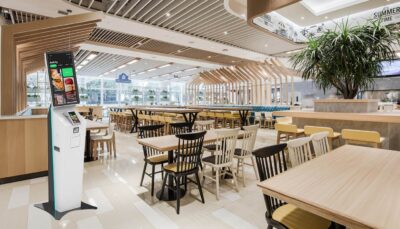用于订餐的自助支付终端确实可以改变就餐体验, 为顾客和餐厅提供多项优势. Here’s how they bring a new dimension to dining:
Customer Experience Enhancements:
- Convenience and Speed: Customers can place their orders and make payments quickly without waiting in line. This reduces wait times and streamlines the ordering process, allowing diners to receive their food faster.
- Customizable Orders: Self-service terminals often allow customers to customize their orders more easily. Options for modifying ingredients, selecting portion sizes, or adding special instructions are usually presented clearly and can be adjusted with a few taps.
- Order Accuracy: By entering their own orders, customers reduce the likelihood of miscommunication or errors that might occur when relaying orders to a staff member. This can lead to more accurate orders and increased satisfaction.
- Menu Exploration: Terminals typically provide detailed menus with images, descriptions, and nutritional information. This helps customers make more informed choices and discover new items they might not have noticed otherwise.
- Payment Flexibility: Customers can pay using various methods, including credit/debit cards, 移动支付, or even gift cards, without needing to handle cash or wait for a server.
- Privacy: Some diners prefer the anonymity of ordering through a terminal, which can be particularly beneficial for those who are shy or want to avoid interactions.
Restaurant Benefits:
- 提高效率: With customers placing orders directly through terminals, restaurant staff can focus on food preparation and service rather than taking orders and handling transactions. This can lead to faster service and reduced labor costs.
- Reduced Order Errors: Self-service terminals help minimize human errors by allowing customers to input their own orders. This can improve overall order accuracy and reduce waste.
- Upselling Opportunities: Terminals can be programmed to suggest add-ons or upgrades based on the customer’s initial order, increasing the average check size and boosting revenue.
- 数据收集和见解: Self-service terminals collect data on customer preferences, popular items, and peak ordering times. This data can be analyzed to optimize menu offerings, pricing strategies, and staffing levels.
- Improved Hygiene: In the wake of increased health and hygiene awareness, self-service terminals reduce physical contact between customers and staff, which can be a crucial factor in maintaining a clean and safe dining environment.
- Enhanced Customer Flow: By decentralizing the ordering process, restaurants can manage customer flow more effectively, reducing congestion at the counter or cash register.
- Features of Self-Service Payment Terminals for Food Ordering:Intuitive Touchscreen Interface: Clear and user-friendly touchscreen interfaces make it easy for customers to navigate menus and complete transactions.
- Visual and Textual Menu Information: Detailed images and descriptions of menu items help customers make informed choices.
- 自定义选项: The ability to customize orders, such as adding or removing ingredients, is typically available.
- Order Confirmation and Receipt Printing: Customers receive a confirmation of their order and a printed receipt or digital confirmation for tracking their order.
- Integration with Kitchen Systems: The terminal integrates with kitchen display systems to ensure orders are sent directly to the kitchen, improving order management.
- 多语言支持: Multiple language options cater to a diverse customer base, enhancing accessibility and convenience.
全面的, self-service payment terminals for food ordering represent a significant advancement in dining technology, offering greater convenience, 准确性, and efficiency while enhancing the overall customer experience.



